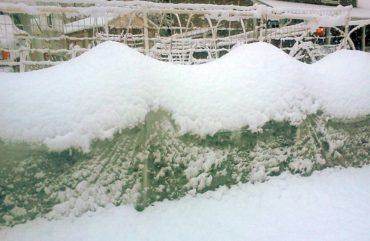
(Photo courtesy Gayle Larson, Dancing Raven Design)
As cold weather arrives, gardeners’ thoughts turn to the best approaches of protecting their overwintering crops and tender ornamentals. Simple structures can benefit gardens year round.
The Winter Garden
What a treat it is to venture out into the garden in the coldest months of the year to discover some treasures for the dinner table. The holidays are even more special if the feast includes vegetables you grew yourself.
The winter garden is more accurately described as the overwintering garden, since the plants need to be started in midsummer to early fall and are kept in the ground over the cold season for winter and early-spring harvest.
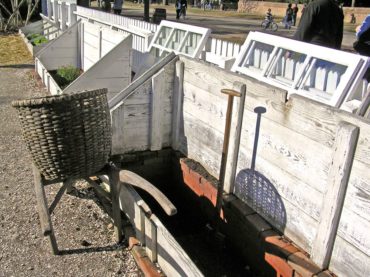
Some vegetables, like kale and brussel sprouts, benefit from a cold spell to bring out the best flavor. Others, like salad greens, sprouting broccoli and chard, will be of better quality if protected by a cloche or polytunnel. Vegetables suited to overwintering also include beets, carrots, onions, oriental vegetables, savoy cabbage, kohlrabi and collards.
The ravages of winter come in many forms. Wind desiccates plants and makes them more susceptible to frost. Excessive rain can rot crops and reduce the quality of leafy vegetables. Snow can crush plants.
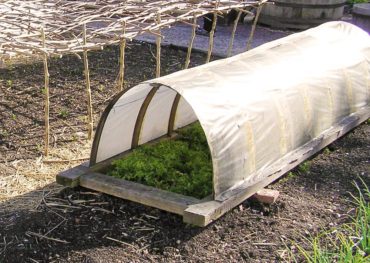
West Sound gardens are protected by the weather-moderating effects of the waters of Puget Sound. You can further improve the odds by siting your vegetable gardens on south-facing slopes and away from north-facing depressions that trap cold air. Siting a garden midway on a hillside will allow cold air to escape downhill as well as allowing water to flow away from roots.
Using a simple shelter made of plastic or glass will force wind to flow over the protected plants and will shed excess water. Gardeners can also moderate the temperatures within a cold frame by using decomposing manure below the planting soil, using a heating cable or including a string of incandescent holiday lights.
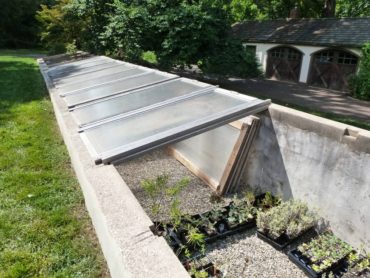
The Spring Garden
The gardener can get an early start planting seed and seedlings under cover. A polytunnel or cold frame will provide a drier, warmer seedbed in the wet spring season. A cover will also keep hungry birds from devouring the tender shoots of peas and lettuce.
Prior to planting, the soil can be covered with black plastic to capture more of the sun’s heat. A cold frame is also a perfect place to harden off seedlings started indoors.
The temperature within these structures needs to be moderated by opening one or both ends of the polytunnels or propping up the lids of cold frames on sunny days. A thermometer within the structure would be a useful tool to help monitor the temperature. The bed can be covered by row-cover fabric like Reemay or Agribon, which will not heat up like the other materials.
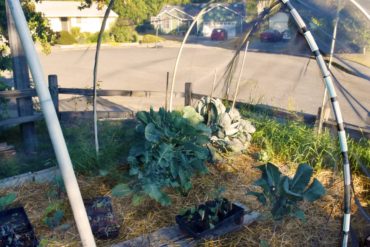
The Summer Garden
Once the temperatures warm, you will want to protect your crops from pests and excessive heat, as well as provide higher temperatures the heat lovers crave. The plastic on polytunnels can be switched out to spun row-cover fabric like Agribon or some bulk fiberglass window-screening material, sealed well along the bottom, to protect against insects like the cabbage butterfly and carrot rust fly. The light shade provided by these covers helps crops like salad greens remain more tender during the heat of summer.
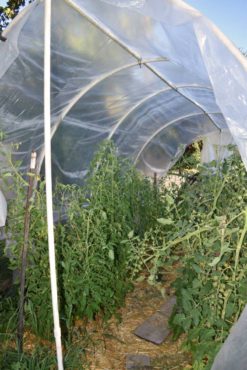
Using 1/2- to 1-inch netting will keep birds off fruits like blueberries and rabbits and deer from devouring your greens, yet allow pollinators to do their work. The stiffer plastic netting will be less likely to entrap birds than the fine, 1/2-inch black mesh that is difficult to see.
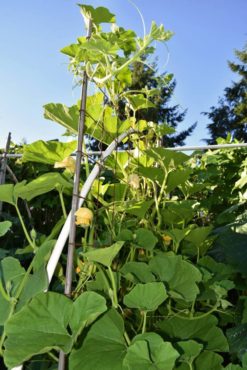
Heat lovers like melons, cucumbers, tomatoes and peppers will enjoy the extra heat trapped by clear plastic. Good ventilation is important to keep fungal diseases at bay as well as moderate the temperature, and this can be achieved by keeping the sides rolled up in polytunnels.
Deeper cold frames that have had their covers removed can provide the perfect growing conditions for heat lovers as well.
A shade lattice placed over a cold frame creates an instant shade garden for summer lettuce.
To make the frames of hoophouses even more useful, use a sturdy material like galvanized pipe for the framing, and attach metal fencing or concrete reinforcing mesh to it to provide vertical support to climbers like squash, cucumbers and indeterminate tomatoes. These structures may be left in place year round and used, as appropriate, with rotating crops.
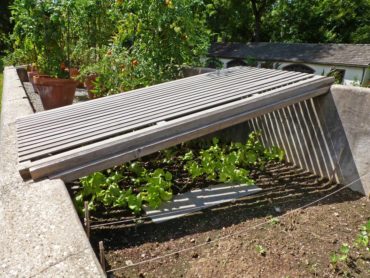
The Fall Garden
As fall rains begin and temperatures drop, you can drape plastic sheeting over the hoophouse supports to delay the onset of late blight on your tomatoes and prolong the season of your summer crops.
Once your garlic has been planted, mulch well with fallen leaves or straw to keep the bulbs protected from excess rain, cold and weeds. Plants like dahlias that are susceptible to rot or frost will also benefit from a cover of fir boughs, fern fronds or a woody mulch once the temperatures dip below freezing.
Cloches, named for the bell-shaped glass domes gardeners used to protect individual plants, are movable covers made from various materials. Milk jugs, glass jugs of various sizes and plastic water containers with the bottoms cut off can all be used to protect individual tender transplants or overwintering plants.
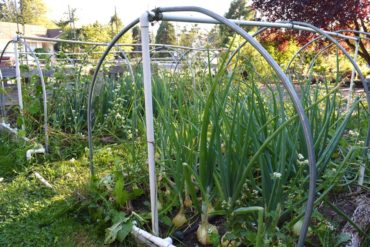
Whole beds can be protected with simple polyethylene-covered hoophouses constructed of PVC pipe, black water pipe, electrical conduit or galvanized steel pipe slipped over 2-foot-long, 5/8-inch-diameter rebar partially hammered into the ground at 3- to 4-foot intervals.
A 10-foot length of pipe will cover a 4-foot-wide bed to a tunnel that’s 3-1/2 feet high. To create a walk-in-height tunnel, use 20-foot-long pipe over a wider bed. Create a ridgeline between the individual hoops with rope or another length of pipe to keep the structure from collapsing. A metal frame provides sufficient support for tying off climbers like tomatoes and for attaching climbing structures to the frame. Metal frames have a long life.
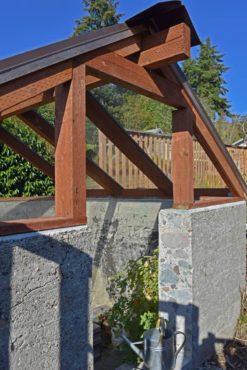
Black plastic water pipe and electrical conduit remain in good condition for many years. White PVC pipe becomes brittle after several years in the sun but is inexpensive and easy to work with. Many fittings are available to help create ridgepoles and other supports, making this material versatile.
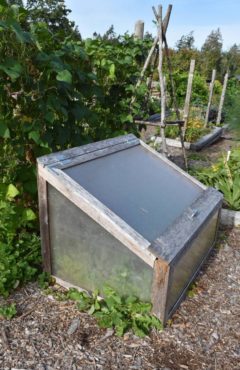
Greenhouse polyethylene will last about four years, while regular plastic sheeting may break down after one year. You can use row-cover snap clamps (metal or PVC) or small spring clamps to attach the cover material to the hoops. Running a length of rope on the outside of the plastic sheeting will keep it from fluttering on windy days and blowing off the frames.
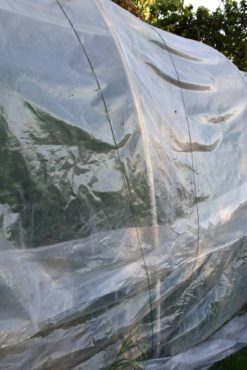
Cold frames retain more heat than hoophouses due to their solid sides. They can be partially sunken into the ground, or the sides can be insulated with foam insulation to retain heat. The lid is often made of recycled materials like windows or from lighter polycarbonate sheeting.
For a warmer environment, the bottom can be layered with fresh manure beneath the planting medium. The decomposition of the manure will release heat.
In addition to providing sheltered conditions for seedlings, cold frames provide ideal conditions for rooting cuttings.
Gardeners have many opportunities to upcycle found objects; find new uses for old, unused structures; and extend their enjoyment of the outdoors into the dreary months of winter. Even an old, unsightly concrete structure long used for garbage can become a useful sunken greenhouse by cutting an access hole in one of the walls and building a simple roof made of recycled sliding-door glass.






























